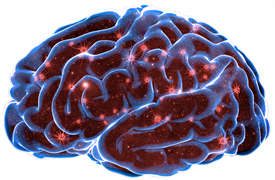
Managing asthma in adults can be tricky because the condition can stem from several causes and treatment often depends on what is triggering the asthma. A team of experts from UTMB, including Department of Internal Medicine professor
Dr. William Calhoun and assistant professor
Dr. Jennifer McCracken, examined and summarized the current information available from many different sources on diagnosing and managing mild to moderate asthma in adults. They determined that essential, effective treatment must involve a physical and breathing exam, along with a comprehensive health history of the patient that includes questions about an individual’s possible triggers. The study authors noted that a key part of asthma management is a written action plan that details the signs and symptoms of worsening asthma and the steps needed to combat it in layman’s terms. The findings are now available in the Journal of the American Medical Association. Asthma affects nearly 8 percent of adults and leads to 1.8 million hospitalizations and 10.5 million visits to the health care provider’s office each year in the U.S. Other authors include UTMB Drs. Sreenivas Veeranki and Bill Ameredes. The study was supported by The National Institutes of Health.
 Dr. Krishna M. Bhat,
Dr. Krishna M. Bhat, a professor in the Department of Neuroscience and Cell Biology, and his lab have shed light on how the developing brain ensures that connections between brain cells reach their intended destination and are also maintained during their life-span. The findings have been published in the journal Science Signaling. Like other networks, the brain contains regions that serve specific functions such as interpreting sensory information, controlling bodily movement or forming memory, among others. In order for regions to interact with one another to perform complex tasks, the brain has a web of interconnecting pathways. The study showed that a protein called Slit is required for maintaining the interconnecting pathways in the nervous system. Without continual guidance from Slit, the pathways drift off course. The study found that Slit keeps brain cells on their paths in partnership with receptor proteins called Robo. The study also revealed that Slit-Robo signaling is controlled by an enzyme called Mummy. Mummy modifies Slit in such a way that it could be secreted outside the cell where it is made, and also maintains correct amounts and spatial distribution of Robo during early and late nervous system development. This has implications for studying loss of cognition and other brain functions as people age or in many neuro-diseases. Other authors include UTMB Drs. Mary Ann Manavalan, Vatsala Ruvini Jayasinghe and Rickinder Grewal.

Scientists at UTMB have unraveled how certain proteins work together to regulate the formation of connections between neurons. The human brain contains an estimated 100 billion neurons that communicate with each other through hundreds of trillions of synapses, the contact and communication points between connected neurons. In a study published in the journal Neuron,
Dr. Gabby Rudenko, associate professor in the Department of Pharmacology and Toxicology, and other researchers at UTMB focused on proteins that reach out across and bridge the cleft between two neurons. The traditional school of thought has been that one protein from each side of the synaptic cleft combine to form a trans-synaptic bridge that helps form and/ or stabilize a synapse. However, sometimes a third molecule can block this connection by getting in between the two proteins. By determining their three-dimensional structures, Rudenko and her colleagues revealed how trans-synaptic bridges formed by the proteins neuroligins and neurexins can be blocked by a third competing protein known as MDGA, regulating the synapse development. Understanding these synaptic connections is critically important work that could have an impact on designing new treatments for neurological diseases. Other authors include Dr. Shanti Pal Gangway, Xiaoying Zhong, Suchithra Seshadrinathan, Dr. Hui Chen and Dr. Mischa Machius.
Compiled from press releases written by Donna Ramirez and Christopher Smith Gonzalez. Find out more at www.utmb.edu/newsroom.